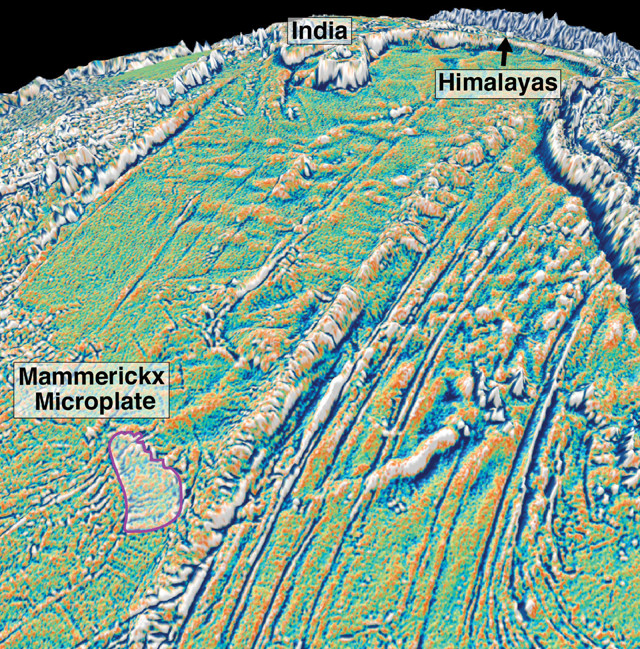
by Mary Caperton Morton Wednesday, March 2, 2016

By dating crust that broke off during the initial collision between India and Eurasia, scientists have been able to pinpoint the birthdate of the Himalayas for the first time. Credit: University of Sydney
The Himalayas are the highest and widest mountain range on the planet, but when they began forming has never been clear. In a new study, researchers have now pinpointed the date of the initial collision between India and Eurasia that led to the birth of the Himalayas.
In the study, published in Earth and Planetary Science Letters, scientists relied on satellite radar imagery of the seafloor under the central Indian Ocean. The imagery revealed a unique jagged section of the seafloor, characterized by a rotating pattern of grooves and hills. Kara Matthews of the University of Sydney in Australia and colleagues identified this seafloor section as a previously undiscovered tectonic plate — dubbed the Mammerickx Microplate — that must have formed during the plate collision between India and Eurasia.
About 50 million years ago, India was moving north at a tectonically speedy rate of 15 centimeters a year when it slammed into Eurasia. Matthews and her colleagues propose that this massive collision altered the prevailing tectonic stresses far to the south at the plate boundary, causing a chunk of seafloor to break free from the surrounding oceanic crust and form the Mammerickx Microplate. By reconstructing the jigsaw puzzle of tectonic plates and calculating the distances the plates have traveled over time, the team dated the formation of the microplate — and the collision — to 47 million years ago, providing one of the first concrete dates for the birth of the Himalayas. Previous age estimates had ranged from 34 million to 59 million years.
“Dating this collision requires looking at a complex set of geological and geophysical data, and no doubt discussion about when this major collision first started will continue, but we have added a completely new, independent observation,” said co-author Dietmar Müller, also of the University of Sydney, in a statement.
© 2008-2021. All rights reserved. Any copying, redistribution or retransmission of any of the contents of this service without the expressed written permission of the American Geosciences Institute is expressly prohibited. Click here for all copyright requests.